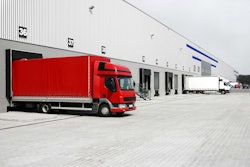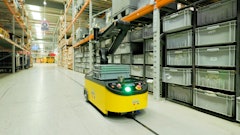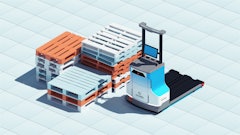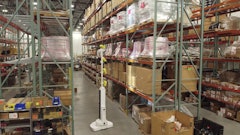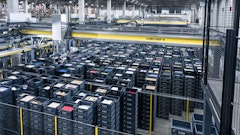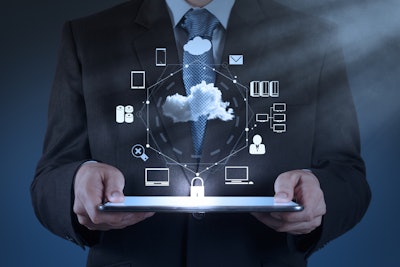
Technology encompasses every aspect of the supply chain, creating better visibility and control over inventory, increased efficiency, and even helping to reduce operational costs.
Tools that once were only accessible to large industrial companies now are increasingly used across the industry, including the implementation of an enterprise resource planning (ERP) system. A fairly simple technological upgrade, companies of all sizes have adopted ERP systems over the last 25 years as they continue to adapt to the ever-changing global market.
An ERP system basically controls the day-to-day functions in a business, helping them to operate more effectively. It does the accounting, order processing, purchasing, inventory management, and most importantly, it integrates data and information from all departments across an organization.
Joe Scioscia, vice president of sales, VAI, a software developer that specializes in ERP, notes that an ERP can increase productivity across their entire enterprise by sharing all company information between the different departments electronically.
Taking on a New Shape
As ERP systems continue to find their place in the supply chain, the technology has begun to take on a new form. ERP systems have come a long way since their first implementation in the early 1990s, when the only choice was an on-premise model. The majority of companies still prefer the original, but as the technology has evolved over the last 20 years, vendors are seeing more and more options, such as a cloud-based system that can be distributed through the internet and accessed by end-users via web browsers. Often used as a metaphor for the internet, cloud computing means storing and accessing data and programs over the internet instead of your computer’s hard drive.
So what exactly is the difference between an on-premise ERP and the cloud-based solution?
According to an article, “How Cloud ERP Compares to On-Premise ERP,” published by Oracle + NetSuite, the basic difference between on-premise ERP and cloud ERP is all about location.
“On-premise ERP solutions are installed locally on your company's hardware and servers and then are managed by your information technology (IT) staff, while cloud ERP—also called SaaS, or Software-as-a-Service—is provided as a service. With this type of deployment, a company's ERP software and its associated data are managed centrally (in the internet cloud) by the ERP vendor and are accessed by customers using a web browser,” the article explains.
For Your Benefit
Cloud-based ERP solutions offer four key advantages, including cost, customization, improved performance and accessibility, and deployment speed.
1) Cost—On-premise ERP systems usually require a large upfront cost to purchase and manage the software and related hardware, servers and facilities necessary to run it. And without a large or experienced IT staff, additional investment in personnel and training can add up quickly.
Even more importantly, on-premise systems require a significant amount of time from a company’s IT team, ensuring your system is up and running when you need it, including maintenance of hardware, server rooms and more. This indirect cost is often reflected in their budget.
According to the Oracle and NetSuite article, initial costs for cloud-based ERP typically are much lower because you simply implement the software to your requirements, and then access it through your computer's internet connection. “The cloud ERP provider hosts and maintains all of the IT infrastructure for you, ensures the system is always running, that the data are secure and that product enhancements are rolled out painlessly to your solution without breaking your previously implemented customizations.”
Over time, those IT savings add up. When comparing the total cost of ownership of on premise ERP solutions relative to cloud systems, a study, “The TCO of Cloud Computing in the SMB and Mid–Market Enterprises; A total cost of ownership comparison of cloud and on–premise business applications," by Hurwitz & Associates, found that cloud-based ERP can cost 50 percent less than on-site ERP for a 100-employee company over a four-year period.
Many providers of cloud-based ERP systems also offer a simple pay-as-you-go subscription model.
2) System Upgrades and Enhancements—On-site ERP software can be customized, but those customizations often are tied to a company’s current software deployment and are not easy to re-implement with future versions, explains “How Cloud ERP Compares to On-Premise ERP.”
“As your ERP provider releases new product updates and enhancements, your previously implemented customizations will be wiped out when you upgrade, and your IT team will have to start customizing from scratch again. That's the main reason many companies simply avoid upgrading their on-site ERP software and just settle for running their business on out-of-date technology,” the article explains.
VAI customer, Black River Produce, a fresh food distributor based out of Vermont, fell into the second scenario before transitioning to a browser-based system by VAI. As the business quickly expanded, their original ERP could not keep up with the business’ growing demands.
“We scouted out different software systems for about a year and half before choosing VAI S2K Enterprise for Food,” says Black River Produce President Sean Buchanan. “Our goal was to really transform the way that we do business, to be more efficient, to be able to service our customer better, to be able manage our product and quality better, get a real-time accurate inventory count, online portal access. Everything that our business wanted to do, we felt confident that with VAI guiding the software programming, it was going to get there.”
One of the most innovative tools S2K’s browser-based software provides is mobile access, which enables every user in the organization immediate anytime, anywhere computing on any device. By delivering software through a browser via the cloud, VAI can provide the user with a single sign on of all web applications, which simplifies the user experience, increases productivity and minimizes training costs.
Additionally, cloud ERP solutions continually are upgraded by the provider, so a business is always using the latest, most advanced version of their software and any implemented customizations and integrations automatically carry forward.
3) Improved System Performance and Accessibility—Cloud ERP often delivers better performance than on-premise solutions, which can mean better application availability than traditional on-site ERP systems.
For example, Oracle + NetSuite commits to 99.5 percent availability for its customers, has 99.97 percent average uptime performance over the past 12 months, and makes uptime performance information available to all customers at all times online.
“We are seeing companies move to the cloud more and more who are taking advantage of the built in infrastructure that the cloud provides,” Scioscia adds. “One of the things the cloud provides that is very attractive is high availability and disaster recovery, meaning that by being in the cloud they can really improve their uptime and have less of a change for any type of system outage.”
There is, however, some resistance from companies that are 24/7 operations, because being up and running is critical to them. Scioscia says some companies feel that if the server is on premise there will be less chance for down time, which is related to an internet outage.
VAI offers both on-site and cloud-based ERP systems, but typically leads with the cloud to show companies the vast benefits and how they can take advantage of lowering infrastructure costs.
“No matter you’re preference, VAI begins the implementation in the cloud. During the implementation process, the customer can choose whether they would like to stay in the cloud or bring in on premise servers. It gives the customer the ability to check it out to see if they like the cloud, if the speed, the uptime, the reliability is what they want it to be,” Scioscia says. “We are seeing a lot of customers staying in the cloud who are presently surprised by what the cloud can offer them.”
Black River Produce is one example of a 24/7 operation that saw how the benefits of a cloud-based system outweigh any risks.
“The food distribution model is changing at a very, very fast pace, and the technology for it is changing very quickly. VAI has been able to keep up with those changes and keep us ahead of the curve,” Buchanan says. “If we were with another system that wasn’t as customizable and responsive, we would probably be looking at declining sales and losing market shares. We’re an aggressive company; we expect double digit sales growth 24/7, and VAI keeps up with that aggressive model.”
4) Deployment Speed—Every ERP deployment takes time and requires careful planning, but cloud ERP offers clear advantages when you consider speed of deployment. The Oracle + NetSuite article notes that because cloud ERP requires no additional hardware, a business doesn't have to waste time procuring and installing IT infrastructure, easily rolling it out across multiple regions, subsidiaries and divisions without added cost.
Cloud ERP deployments usually take 3-6 months, compared to the 12 months that it typically takes to implement an on-premise solution.
Black River Produce, who Buchanan says is one of the most complicated food distributors in the market, implemented their VAI solution from ground up in about 10 months. The 7-day a week operation was able to remain open throughout the entire process, and the president says “customers didn’t notice any large hurdles” while Black River Produce adapted to the new system.
“From an implementation standpoint, cloud solutions let you get up and running a little quicker than an on-premise because basically you’re plugging into an infrastructure that already exists, and you can get started right away,” states Scioscia. “When you deal with on-premise serves, you have to set up the servers, load the servers, integrate your network with the server, so from an infrastructure standpoint, on premise takes a little longer to get up and running.”
There’s No Reward without Risk
The benefits of a cloud-based system are significant, but many companies remain concerned, especially in those areas where high-speed internet is limited, notes Scioscia.
“The biggest restriction on moving to cloud is still the availability of high speed internet in a location,” Scioscia says. “Obviously in major cities high speed internet is readily available, but as we span out across the United States or North America, there are still locations that don’t really have good, reliable high speed internet. So if you don’t have it, cloud is not really an option for you.”
Another fear many companies have in regards to cloud-based solutions is the protection of data.
“Some people don’t like to put things in the cloud because they are afraid of moving their data out to the open world,” notes Scioscia. “But security has really evolved in most cloud solutions, where companies today are much more protected from a data standpoint than they’ve ever been in the past.”
Because it's their core competency, Cloud ERP providers like Oracle + NetSuite make securing their systems a top priority by providing strong, industry standard data security certifications such as compliance with PCI DSS and SAS 70. Moreover, they solution providers follow other rigorous security, disaster recovery and backup procedures that would be cost-prohibitive with on-site ERP solutions.







